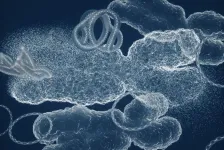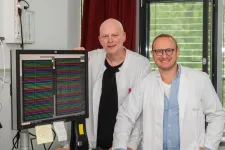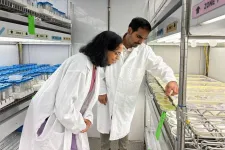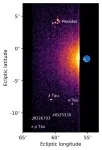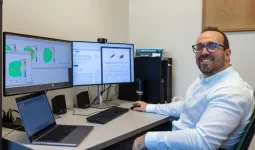(Press-News.org) How bladder cancer originates and progresses has been illuminated as never before in a study led by researchers at Weill Cornell Medicine and the New York Genome Center. The researchers found that antiviral enzymes that mutate the DNA of normal and cancer cells are key promoters of early bladder cancer development, and that standard chemotherapy is also a potent source of mutations. The researchers also discovered that overactive genes within abnormal circular DNA structures in tumor cells genes drive bladder cancer resistance to therapy. These findings are novel insights into bladder cancer biology and point to new therapeutic strategies for this difficult-to-treat cancer.
The study, published Sept. 9 in Nature, focused on the main form of bladder cancer, urothelial carcinoma, which originates from cells that line the bladder, urethra, and tubes that drain urine from the kidneys. The researchers examined malignant and pre-malignant urothelial cells taken from the same set of patients at different disease stages. They used whole-genome sequencing and advanced computational methods to map common DNA mutations, complex structural variants, and their timing.
“Our findings define new fundamental mechanisms driving bladder cancer evolution—mechanisms that we can now think about targeting with therapies,” said co-senior author Dr. Bishoy Faltas, the Gellert Family–John P. Leonard MD Research Scholar in Hematology and Medical Oncology and an associate professor of medicine and of cell and developmental biology at Weill Cornell Medicine, and an oncologist at NewYork-Presbyterian/Weill Cornell Medical Center.
Dr. Nicolas Robine, director of computational biology at the New York Genome Center, and Dr. Olivier Elemento, director of the Englander Institute for Precision Medicine and a professor of physiology and biophysics at Weill Cornell Medicine, also led the study with Dr. Faltas. The co-first authors were Duy Nguyen, a technician in the Faltas Laboratory (now a doctoral student at Harvard Medical School); William Hooper, a bioinformatics scientist at the New York Genome Center; and Dr. Weisi Liu, an instructor in the Faltas Laboratory.
Major Therapeutic Targets Come into Focus
Bladder cancer occurs at the rate of about 80,000 cases per year in the United States. It can be cured with surgery if caught early, but about 30 percent of cases are diagnosed at later stages when it is much harder to treat successfully.
The researchers in the new study found strong evidence that the APOBEC3 enzymes cause early mutations that may help trigger the development of this cancer type. These enzymes evolved to disable infecting retroviruses by editing their viral DNA, though it is known that they can sometimes mutate cells’ own DNA.
“The exact role of APOBEC3-induced mutations in cancer initiation hasn’t been clear,” said Dr. Faltas, who is also the chief research officer at the Englander Institute for Precision Medicine and a member of the Sandra and Edward Meyer Cancer Center at Weill Cornell Medicine. “But we found that these mutations appear early in urothelial cancer, occurring even in pre-malignant urothelial tissue.” In his lab, Dr. Faltas is focusing on studying the role of these mutagenic enzymes in driving cancer evolution.
The researchers found that cisplatin and other platinum-based chemotherapies cause further prominent bursts of mutations, some of which likely allow urothelial cancer cells to survive better and spread despite treatment.
A third major finding was that urothelial tumors often contain complex rearrangements of their DNA that give rise to circular segments of DNA. These “extra-chromosomal DNAs” (ecDNAs) exist apart from chromosomes in the cell nucleus and can sometimes harbor hundreds of copies of cancer-driving growth genes. The researchers discovered that these ecDNA events persist and become more complex, incorporating new DNA segments after treatment, suggesting that they drive resistance to therapy.
This prompted the team to experimentally model an ecDNA version of one of these genes, called CCND1, a master regulator of the cell cycle in the laboratory. The results of these experiments confirmed that CCND1 in this extrachromosomal configuration drives treatment resistance.
Altogether, the findings paint a much clearer picture of the factors that trigger and drive urothelial cancer.
“Traditionally, when analyzing tumor genomes, we’ve used methods that analyze only a tiny fraction of their DNA, but we’ve come to realize that there’s a lot more to discover if we sequence all their DNA and use smart methods to evaluate that data,” Dr. Elemento said. “I think this collaboration vindicates that strategy.”
The Englander Institute and New York Genome Center researchers are planning larger future collaborative studies to dig even deeper into urothelial cancer biology, for example, doing whole-genome sequencing of DNA along with readouts of gene activity not just in bulk tumor samples but in individual tumor cells.
“Combining those two sets of information at the single-cell level would be tremendously important and interesting,” Dr. Robine said.
The researchers also plan to study potential clinical applications of this work. The investigators are hopeful that a new FDA-approved drug targeting the ERBB2 gene product—the HER2 receptor protein, also found on breast tumor cells—will work especially well in urothelial cancer patients with strong signs of ERBB2 ecDNAs. They are also working on finding ways to block ecDNA formation and maintenance.
Many Weill Cornell Medicine physicians and scientists maintain relationships and collaborate with external organizations to foster scientific innovation and provide expert guidance. The institution makes these disclosures public to ensure transparency. For this information, see profiles for Dr. Bishoy Faltas and Dr. Olivier Elemento.
The research reported in this story was supported in part by the National Cancer Institute and the National Center for Advancing Translational Science, both part of the National Institutes of Health, through grant numbers R37CA279737, U01CA260369, UL1TR002384; and the United States Department of Defense through grant number W81XWH-17-1-0539. Additional support was provided by the Starr Cancer Consortium, the Leo & Anne Albert Institute for Bladder Cancer Care and Research, the Translational Research Program in the Department of Pathology and Laboratory Medicine at Weill Cornell Medicine and the New York Genome Center’s Polyethnic-1000 Initiative.
END
Study uncovers mutations and DNA structures driving bladder cancer
2024-10-09
ELSE PRESS RELEASES FROM THIS DATE:
A matter of taste: Electronic tongue reveals AI inner thoughts
2024-10-09
UNIVERSITY PARK, Pa. — A recently developed electronic tongue is capable of identifying differences in similar liquids, such as milk with varying water content; diverse products, including soda types and coffee blends; signs of spoilage in fruit juices; and instances of food safety concerns. The team, led by researchers at Penn State, also found that results were even more accurate when artificial intelligence (AI) used its own assessment parameters to interpret the data generated by the electronic tongue.
The researchers published their results today (Oct. 9) in Nature.
According to the researchers, ...
Another step towards decoding smell
2024-10-09
We often only realize how important our sense of smell is when it is no longer there: food hardly tastes good, or we no longer react to dangers such as the smell of smoke. Researchers at the University Hospital Bonn (UKB), the University of Bonn and the University of Aachen have investigated the neuronal mechanisms of human odor perception for the first time. Individual nerve cells in the brain recognize odors and react specifically to the smell, the image and the written word of an object, for example a banana. The results of this study close a long-standing knowledge gap between animal and human odor research and have now been published in the renowned ...
Plant Science Research collaboration will explore key mosses critical to storing carbon
2024-10-09
ST. LOUIS, MO, October 9, 2024 - Plant scientists at the Donald Danforth Plant Science Center and the HudsonAlpha Institute for Biotechnology have been awarded a four-year National Science Foundation (NSF) Enabling Discovery through GEnomics (EDGE) grant to advance their understanding of sphagnum moss, a crucial component of peatlands and a vital player in global ecosystems. The collaborative research team will develop genetic and genomic resources to study sphagnum's life cycle, growth, and adaptation to various environmental conditions.
Sphagnum ...
Researchers examine the persistence of invisible plastic pollution
2024-10-09
Plastic pollution – tiny bits of plastic, smaller than a grain of sand – is everywhere, a fact of life that applies even to newborn rodents, according to a Rutgers Health study published in the journal Science of the Total Environment.
Researchers have long understood that micro- and nanoplastic particles (MNPs), which enter the environment through oxidation and natural degradation of consumer products, are easily deposited in the human body through inhalation, absorption and diet.
Experts also understand that these pollutants can cross the placental barrier and deposit ...
Coffee during pregnancy safe for baby’s brain development
2024-10-09
A University of Queensland-led study has failed to find any strong links between drinking coffee during pregnancy and neurodevelopmental difficulties in children, but researchers are advising expectant mothers to continue following medical guidelines on caffeine consumption.
Dr Gunn-Helen Moen and PhD student Shannon D’Urso from UQ’s Institute for Molecular Bioscience (IMB) led an in-depth genetic analysis of data from tens of thousands of families in Norway.
“Scandinavians are some of the biggest coffee consumers in the world, drinking at least 4 cups a day, with little stigma about drinking coffee during pregnancy,” ...
SwRI-led instrument aboard Jupiter-bound spacecraft nails in-flight test
2024-10-09
SAN ANTONIO — October 9, 2024 —As European Space Agency (ESA)’s Jupiter Icy Moons Explorer (Juice) spacecraft hurtled past the Moon and Earth in mid-August to provide its first gravity assist maneuver to the Jovian system, the Southwest Research Institute-led Ultraviolet Spectrograph (UVS) instrument imaged the UV emissions radiating from the Earth and Moon.
It was a successful test of one of three science instrument projects comprising NASA’s contribution to ESA’s Juice mission. The UVS data collected were then analyzed and found to be consistent with expectations for the Moon and the Earth. This confirmation that the instrument works ...
New AI models of plasma heating lead to important corrections in computer code used for fusion research
2024-10-09
New artificial intelligence (AI) models for plasma heating can do more than was previously thought possible, not only increasing the prediction speed 10 million times while preserving accuracy, but also correctly predicting plasma heating in cases where the original numerical code failed. The models will be presented on October 11 at the 66th Annual Meeting of the American Physical Society Division of Plasma Physics in Atlanta.
“With our intelligence, we can train the AI to go even beyond the limitations ...
Study: Rise in English learner students in “new destination” states helps, does not hurt, academic outcomes for existing students
2024-10-09
Washington, October 9, 2024—English learner (EL) students represent the fastest growing student group in the United States over the past two decades, with numbers of EL students in public schools soaring in “new destination” states across the South and Midwest. Some commentators have expressed concerns about the possible adverse effect of immigrant students on current students if they require additional resources that are diverted from their peers.
However, a new study finds significant positive spillover effects ...
LANDFEED project kicks off: Transforming agro-food waste into bio-based fertilizers to support Europe’s circular economy
2024-10-09
The LANDFEED project, co-funded by the European Union, held its official kick-off meeting on 12-13 September in Bilbao, Spain. Coordinated by Miriam Pinto from NEIKER, LANDFEED brings together experts across Europe to implement sustainable, circular solutions to Europe’s waste challenges, helping to increase the continent's self-sufficiency in agricultural resources while reducing environmental impact.
LANDFEED will focus on converting under-utilised waste from the agri-food industry, forestry, urban centres, and the natural environment into ...
Mcity opens for remote testing of autonomous vehicle technologies, calls for federal standards
2024-10-09
Images/Videos
As Mcity begins welcoming researchers in autonomous and connected vehicle technologies from around the U.S. to be remote users of its physical and virtual testing environment, its leadership is calling for federal standards for safety testing, arguing that the lack of clear goalposts is hampering development.
The opening also coincides with a new industry partnership project announced at the NVIDIA AI Summit.
Following two years of upgrades, the University of Michigan's hub for autonomous testing has officially kicked ...
